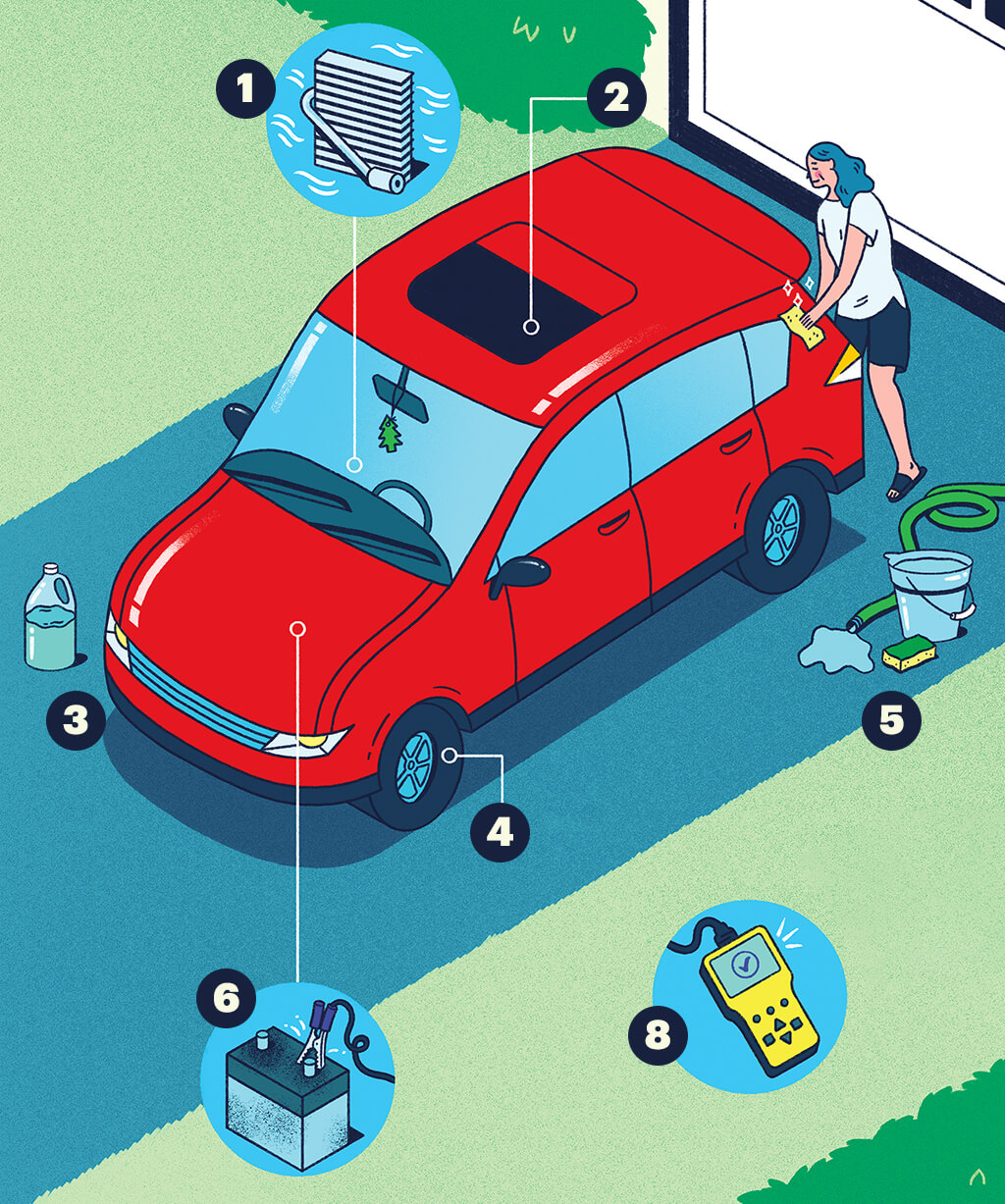Your Life
GET MORE MILEAGE OUT OF YOUR CAR
Take these steps to keep your ride on the road
BY MICHAEL FRANK
ILLUSTRATION BY JOSIE NORTON

Car prices are skyrocketing. According to Kelley Blue Book, the average new set of wheels ran more than $48,000 in February. And economists say that tariffs could cause prices to rise further. The good news is you can make your current car last longer. Here are maintenance tips that you won’t necessarily glean from the owner’s manual.
1. BREATHE FRESH
An evaporator with a blocked drain tube (which works as part of the cooling system) can lead to mold problems inside the car. Mechanic Devin Cabungcal, an automotive expert for Car Genius, recommends having a technician check the evaporator for contamination or moisture. “A lot of times what’s in there are spiders or insect eggs, things that you don’t want.” Maintenance is easy; a mechanic can use a foaming cleaner to clean the evaporator. Another spot that should get attention is your engine’s throttle body (which controls how much air flows into the engine). Cabungcal explains that intake can get choked with gunk. That often doesn’t trigger the check-engine light, but if you notice your car running rough, get that checked out.
2. AVOID WATER DAMAGE
Cars have drains—typically covered by rubber strips—that channel water away so it doesn’t pool. When those get clogged, rust and mold can develop. Car Genius’s Bo Fader says that cars with sunroofs can be especially susceptible to poor drainage. Drains that route water around trunks and hatches can also get clogged. And driving on dirt roads can jam door drains with dust and debris. The solution: A car shop will blow compressed air through the drainage channels to clear them.
3. CHECK FLUIDS MONTHLY
Low fluid can lead to damaged parts; checking fluids monthly is an easy way to detect a leak early. If you wait until you see a spot on the garage floor, it may be too late. “It can save you really expensive repairs,” Fader says. Consult your car’s manual for recommended fluid levels and how to monitor each. Check the oil, coolant and transmission fluid.
4. ALIGN YOUR TIRES
Tires will wear down faster when the wheels are out of alignment. So get that checked once a year. “An alignment check is like 50 bucks, and getting an alignment is like 125 bucks. That’s far better than $800 for four new tires,” says Fader, who managed a shop of master technicians for 15 years.
5. WASH IT
If you live in a place where roads are salted in winter, or in a community on the coast with ocean air, getting your car washed is particularly important. That’s because salt is corrosive and can harm your car’s exterior. Tree sap can also damage a car’s paint, Fader says. Washing at least monthly helps maintain the value of your car. Be sure to go to a car wash that has high-pressure jets to clean the undercarriage. “You want to make sure the suspension pieces and anything metal on the frame is kept clean of salt and dirt,” Fader says.
6. SAVE YOUR BATTERY
Corroded terminals will reduce battery life, Fader says. If you see corrosion—crumbly or ashy residue that’s white, blue or green—be sure to have your shop remove it.
7. GO FOR A LONG DRIVE
Driving only short distances could cause unexpected damage to your car, Cabungcal says. “If you’re just driving a mile to the grocery store and back, that can take a big toll on the engine and, honestly, a lot of parts of the car.” Cabungcal says that for low-mileage drivers, getting a car up to highway speed on occasion is a necessity, to recharge the battery and circulate the car’s lubrication. Hit the open road at least once a week for about 20 minutes.
8. GIVE YOUR CAR A YEARLY PHYSICAL
To keep your car running well, Cabungcal and Fader both say you should take it in for an annual “physical,” regardless of the service intervals suggested by the manufacturer. That should include an oil change and an overall check of the engine, plus the steering, suspension, brakes, belts and hoses, Fader says. The mechanic should also check the car’s diagnostic computer, which can flag any systemic faults or open recalls. You also shouldn’t necessarily shop around for the best price on each repair. “Find a repair shop that you trust and stick with it,” says John Ibbotson, chief mechanic at Consumer Reports. “It’s the best way to ensure that you’re getting consistent, reliable, quality work done.” Just as your primary care physician keeps a record of your health, a good mechanic will know which parts need monitoring.
Michael Frank is a contributor to national publications, including Consumer Reports, Men’s Journal and Gear Patrol.